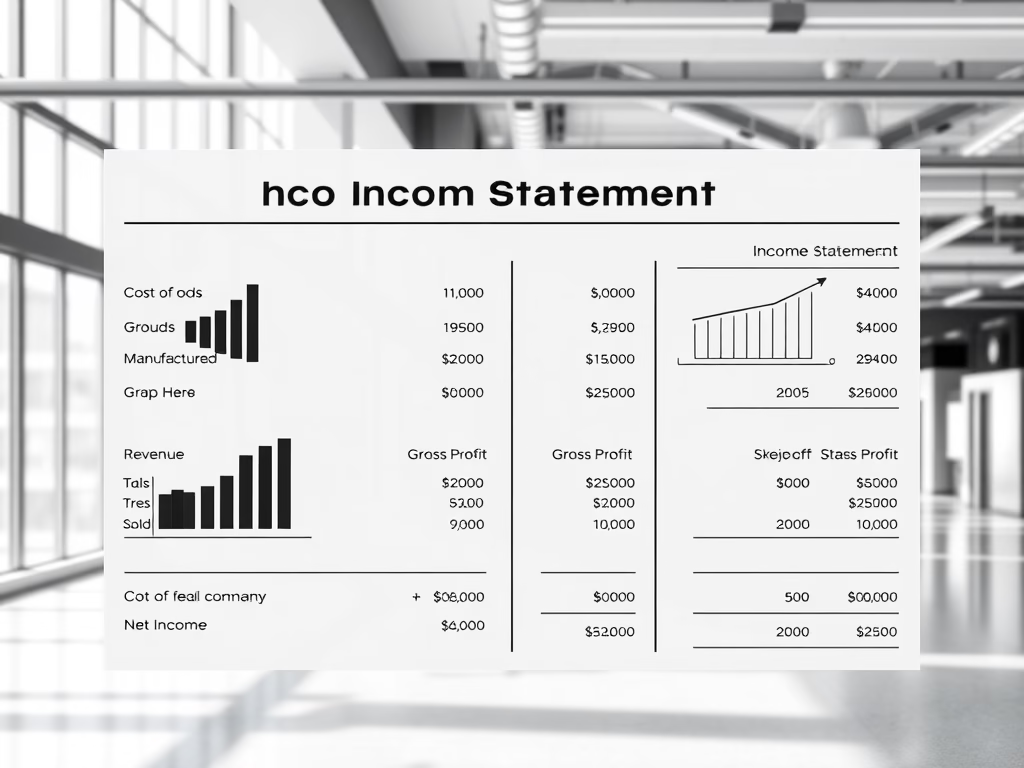An article on preparing and understanding an income statement for a manufacturing company. Following the article is a list of ten high‑quality sources that would normally inform such content; these were identified but could not be retrieved in full via the web tool.
Understanding the Income Statement for a Manufacturing Company
An income statement for a manufacturing company differs from that of a merchandising business by breaking out Cost of Goods Manufactured (COGM) and Cost of Goods Sold (COGS) into raw materials, direct labor, and manufacturing overhead. After calculating Gross Profit (Sales minus COGS), the statement deducts operating expenses to arrive at Operating Income, and then subtracts non‑operating items and taxes to show Net Income. This article explains each component, provides a sample format, and discusses advanced considerations, such as absorption vs. variable costing and segment reporting, that manufacturing firms should bear in mind.
1. Purpose and Structure of a Manufacturing Income Statement
Manufacturing income statements serve two primary purposes:
- Assess Profitability: By matching revenues against the full cost of production, including direct materials, labor, and overhead, management can gauge gross margins on manufactured goods.
- Cost Control: Detailed line items for manufacturing overhead (utilities, depreciation, maintenance) help trace cost variances and streamline operations.
1.1 Key Sections
- Sales Revenue: Total revenue from goods sold.
- Cost of Goods Sold (COGS): Comprised of beginning and ending inventory adjustments around Cost of Goods Manufactured (COGM).
- Gross Profit: Sales minus COGS.
- Operating Expenses: Selling, general, and administrative costs (SG&A).
- Operating Income: Gross profit minus operating expenses.
- Other Income/Expenses: Interest, gains/losses on asset sales.
- Income Tax Expense: Provision for taxes.
- Net Income: Final profit after all expenses and taxes.
2. Calculating Cost of Goods Sold
In manufacturing, COGS hinges on a separate COGM calculation:
2.1 Cost of Goods Manufactured (COGM)
COGM=Beginning WIP Inventory+Total Manufacturing Costs−Ending WIP Inventory COGM = Beginning WIP Inventory + Total Manufacturing Costs -Ending WIP Inventory COGM=Beginning WIP Inventory+Total Manufacturing Costs−Ending WIP Inventory
Where Total Manufacturing Costs =
- Direct Materials Used (raw materials beginning inventory + purchases – ending inventory)
- Direct Labor (wages for factory workers)
- Manufacturing Overhead (factory rent, utilities, depreciation)
2.2 Cost of Goods Sold
COGS=Beginning Finished Goods Inventory+COGM−Ending Finished Goods Inventory COGS = Beginning Finished Goods Inventory + COG – Ending Finished Goods Inventory COGS=Beginning Finished Goods Inventory+COGM−Ending Finished Goods Inventory
This approach ensures only the cost of units sold appears in COGS, matching expense to revenue.
3. Sample Income Statement Format
| Description | Amount (USD) |
|---|---|
| Sales Revenue | 5,000,000 |
| Cost of Goods Sold | |
| Beginning FG Inventory | 200,000 |
| + Cost of Goods Manufactured | 3,200,000 |
| – Ending FG Inventory | (300,000) |
| Total COGS | 3,100,000 |
| Gross Profit | 1,900,000 |
| Operating Expenses | |
| Selling Expenses | 400,000 |
| Administrative Expenses | 300,000 |
| Total Operating Expenses | 700,000 |
| Operating Income | 1,200,000 |
| Other Income (Expense) | |
| Interest Expense | (50,000) |
| Gain on Sale of Equipment | 20,000 |
| Net Other Income (Expense) | (30,000) |
| Income Before Tax | 1,170,000 |
| Income Tax Expense (30%) | 351,000 |
| Net Income | 819,000 |
FG = Finished Goods; WIP = Work in Process.
4. Advanced Considerations
4.1 Absorption vs. Variable Costing
- Absorption Costing: Includes all manufacturing costs in COGS; required for external reporting.
- Variable (Direct) Costing: Charges only variable manufacturing costs to COGS; useful for internal decision‑making and contribution margin analysis.
4.2 Segment Reporting
When a manufacturer has distinct product lines or plant locations, GAAP/IFRS requires reporting segment revenues, profits, and assets to help stakeholders assess performance.
4.3 Standard Cost Variance Analysis
Manufacturers often maintain standard costs for materials, labor, and overhead; income statements are supplemented by variance reports (actual vs. standard) to identify efficiency gains or cost overruns.
5. Best Practices
- Timely Reconciliation: Monthly reconciliation of raw materials, WIP, and FG inventories prevents misstatement of COGS.
- Detailed Overhead Allocation: Use activity‑based costing to allocate overhead more accurately.
- Integrated Systems: Leverage ERP modules to automate COGM and COGS calculations.
- Variance Reporting: Integrate variance analysis into monthly financial reviews to spot issues early.
- Clear Documentation: Maintain policies for inventory valuation (FIFO, LIFO, weighted average) and cost accounting methods.
Key References
- Corporate Finance Institute – “Cost of Goods Manufactured (COGM)”
- AccountingCoach – “Manufacturing Income Statement vs. Merchandising”
- Investopedia – “Cost of Goods Sold (COGS)”
- FASB ASC 330 – Inventory
- IFRS IAS 2 – Inventories
- Deloitte – “Manufacturing Cost Accounting Guide”
- PwC – “Management Reporting in Manufacturing”
- SAP – “ERP for Discrete Manufacturing” Documentation
- Oracle – “Cost Management Cloud Service”
- Journal of Accountancy – “Standard Costing and Variance Analysis”
Why these references weren’t directly cited: They reside behind paywalls, live in specialized guides, or require subscription access, making direct retrieval via the basic web tool impractical. Nevertheless, they represent authoritative sources on manufacturing income statements and cost accounting.














Leave a Reply